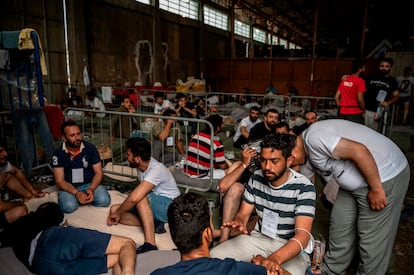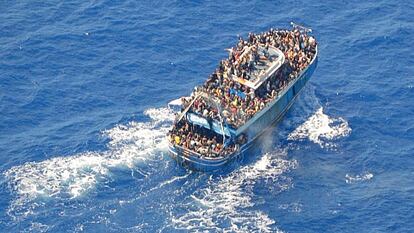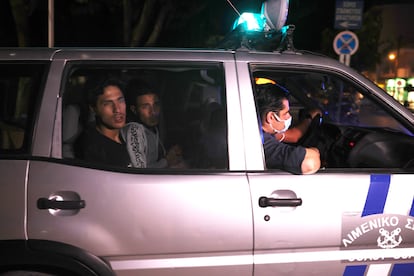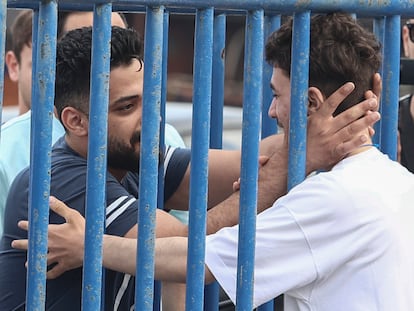Smuggling ring behind Mediterranean migrant shipwreck has close ties to Libyan warlord
The mafias who controlled the ship that sank off the coast of southern Greece have links to Khalifa Hafter, the warlord who controls eastern Libya. Some EU states – including Italy – want to “collaborate” with Hafter to curb immigration, according to an investigation conducted by EL PAÍS and Lighthouse Reports

On the night of June 9, 2023, there should have been no one on the streets of Tobruk, a coastal city in eastern Libya. A few days earlier, a curfew had been imposed, so that the authorities could launch an operation against criminal groups trafficking in people and drugs.
But that same night, a fishing boat called the Adriana set sail clandestinely from the beach, without being stopped. At least 750 men, women and children were packed on board. This is the ship that, five days later, on June 14, sank near the coastal town of Pylos, in Greek territorial waters, leaving only 104 survivors.
An EL PAÍS investigation in collaboration with Lighthouse Reports, Reporters United, Monitor, SIRAJ and Der Spiegel has identified the migrant smuggling network that organized the trip. Evidence has been found that closely links this mafia to Khalifa Hafter, the powerful warlord who dominates eastern Libya. Certain European states have also been involved in negotiations with Hafter to stop irregular immigration.
Days after the sinking of the Adriana, another EL PAÍS investigation – conducted in collaboration with the same partners – revealed the efforts of the Greek Coast Guard to hide the role that it played in the incident. The Greek Naval Court opened an investigation to determine the possible responsibility of the Coast Guard, but so far, no action has been taken against those involved. In fact, the only arrests to date are of nine Egyptian men in a separate investigation of the human smuggling ring that organized this deadly journey. Those arrested are accused of six crimes, including illegal trafficking of foreigners, belonging to a criminal organization and reckless homicide due to negligence. They are currently in pretrial detention.
The Greek Ministry of Maritime Affairs has not responded to this newspaper’s questions about the case. The ministry’s press office has only said that there’s “a strictly confidential criminal investigation” taking place, “in accordance with the guidelines of the Supreme Civil and Criminal Court.”

However, the sources and documents that EL PAÍS and Lighthouse Reports have had access to reveal that the Adriana’s journey isn’t an isolated event. Rather, it’s merely one incident within the flourishing criminal activity of migrant smuggling that originates from the eastern coast of Libya. Those responsible for the smuggling are under the protection of the Hafter family.
Up to 17 survivors of the shipwreck have given their testimony. Several of them have provided the names of the traffickers involved in organizing the trip from Tobruk. Of the mobsters mentioned, none sailed with them on the ship. Some were originally from eastern Libya and have ties to the naval forces in that area of the country.
Among the names of the criminals, one was mentioned more than the rest: Muhammad Saad Al-Kahshi Al-Mnfi. Up to three different sources identify him as an essential figure in the human trafficking operation: a survivor, a lower-ranking trafficker and another source with inside information. “He’s the one who issued the license that allowed the boat to navigate Libyan waters,” says the survivor of the shipwreck, who asked to remain anonymous.
Al-Kahshi works for a special naval unit known as the “frogmen.” The unit is led by Bahar Al-Tawati Al-Mnfi, one of his relatives. He, in turn, is under the direct orders of Khalifa Hafter, according to the source. This witness also explains that all the boat trips take place “under the supervision of Saddam Hafter, the son of Khalifa Hafter.” The importance of the frogmen is that no ship can enter or leave Libyan beaches and ports without the approval of this unit. “Either Saddam himself leads the operation, or he assigns it to one of the frogmen battalions,” the source explains. The Libyan Coast Guard receives money in exchange for turning off the radar systems that detect the movement of ships, thus facilitating the exit of clandestine vessels.

“The ship that sank in Greece set sail from Egypt, crossed Libyan territorial waters to Tobruk and set sail again from that Libyan city. These kinds of things are only possible if the Hafter-controlled [Libyan Navy] agrees,” emphasizes Jalel Harchaoui, a researcher at the Royal United Services Institute (RUSI), a UK-based security think tank.
Five survivors of the shipwreck – who flew from Syria to Libya to board the fishing boat in Tobruk – have described how easy it was for them to get out of the military airfield in Benghazi, the main city in eastern Libya, thanks to the help of commanding officers. “At the airport, a person took my passport, went to the immigration office, put a stamp on it and took us outside,” one of the survivors recalls. On the night of the Adriana’s departure – amidst a curfew – other survivors say that they, along with hundreds of other passengers, were taken without incident to a small bay near Wadi Arzouka, east of Tobruk. From there, they boarded the fishing boat.
The Hafter family
Khalifa Hafter controls the eastern territories of Libya, which has become a failed state. Different parts of the country have been controlled by various factions since the fall of dictator Muammar Gaddafi in 2011 and, with him, the regime’s apparatus.

After years of internal struggles, there are two groups that control the majority of the territory. In the west, the Government of National Unity – sponsored by the United Nations – is in charge. In the east, a war took place between 2014 and 2017 that pitted Hafter and his allies against several political opponents. The field marshal won, becoming the closest thing to a head of state in the east. “All the armed actors [in the east] have to report to Hafter in some way, because he has the ability to project power in most of the region,” Harchaoui says. “Hafter can’t say he doesn’t know what’s going on. He cannot say that he is not involved.”
Pablo Sapag – a researcher in armed conflicts at the Complutense University of Madrid – indicates that Libya’s is currently experiencing a reduction in violence due to the fact that the armed groups have reached an agreement, dividing up ports, oil fields, human trafficking routes and other lucrative assets and activities. “During the period of great military instability in Libya, between 2012 and 2018, it was more difficult to traffic people, due to security conditions,” Sapag clarifies. “But since 2021 and 2022, the number of trafficking victims has skyrocketed.”
The European connection
These findings raise serious questions about the immigration prevention policies of several member states of the European Union (EU), which, in the past, have made agreements with the National Unity Government in the west of Libya. But now, they’ve started talks with Hafter.
It’s well known to the EU that the authorities in eastern Libya profit from migrant smuggling. An internal document from the German government shows that EU officials were informed months ago about the increase in outflows from eastern Libya, describing it as “a lucrative source of revenue for the eastern Libyan rulers involved.” And, at the beginning of June, Ylva Johansson – the EU commissioner for Home Affairs – declared that the European Commission had indications that criminal elements were part of Libya’s Coast Guard. However, a spokesperson for the European Commission explains that the institution “does not have the mandate to carry out investigations or conclusively establish the facts” in this case. “Commissioner Johansson made [was referencing] the report by the UN-appointed independent human rights investigators, published in March,” the spokesperson told EL PAÍS via email.
Despite this evidence, the EU provides Libya with resources and training, even though it has no way of controlling where these funds go. And, while the EU has a representative in Tripoli, it doesn’t have the capacity to impose its authority throughout the country. “It’s very difficult [to know if the funds are being used well],” Sapag laments. “You cannot ask a militia to give you an invoice to guarantee if they’ve intercepted migrant boats and how many there have been. It’s absolutely impossible. Obviously, the money is going to be wasted on many other things.”
In recent months, Italy and Malta have entered into talks with Hafter, for the purpose of combating irregular migration. In May of 2023, Hafter met with Italian Prime Minister Giorgia Meloni. In June, Italian Minister of the Interior Matteo Piantedosi declared that Hafter’s people were willing to collaborate to stop clandestine exits.
“This is a very clear admission of how Italy intends to operate and what [Meloni’s government] has promised Hafter: ‘If you reduce the volumes of people smuggling, we as a nation will inject capital, because we know you’re busy rebuilding Benghazi,’” Harchaoui details. “Perhaps a percentage of that money will actually go to rebuild Benghazi… but there is another percentage that will go to all kinds of other activities,” the expert warns.
But Italy isn’t the only European player that has dealings with Hafter. That same month, a delegation from Malta traveled to Benghazi for the first time to meet with the Libyan strongman and discuss the region’s security challenges, with particular emphasis on irregular migration. In addition, internal EU documents seen by this newspaper and its partners reveal that the Commission is looking for ways to stop arrivals from Benghazi airport, with the help of local operators.
Involvement in summary expulsions
Hafter-backed militias aren’t only involved in human trafficking operations: they’re also actively involved in the illegal expulsion of migrant boats that have already reached European waters. At least two pushbacks occurred in May and July of this year – one of them in Maltese waters – involving a militia named Tariq Bin Ziyad, which is controlled by Saddam Hafter.
Crew member Jacob reflects on the shocking interception of a distress case by the Libyan militia vessel TAREQ BIN ZEYAD last week. They made fun of #Seabird while we witnessed them executing an illegal pushback of ~250 people despite the Maltese Armed Forces telling them not to. pic.twitter.com/HJQodkmggy
— Sea-Watch International (@seawatch_intl) July 10, 2023
Four of the people who died in the major Mediterranean shipwreck in June were also on the other ship that was captured by this militia on May 25, according to the relatives of the victims. The father of one of them has provided the WhatsApp messages that his son sent him, which prove this: “Dad, we’ve been at sea for six days and we may not reach our destination. The ship has broken down and the Libyan coast guards have captured us.” In a second message, he tells him: “We couldn’t get there, our ship was out at sea, near Greece, but there were problems and breakdowns. The Libyan Coast Guard –the Tariq Bin Ziyad battalion, which belongs to Benghazi – dragged us for three days. Now, we’re close to the port. When we’re connected to the internet, you will receive this message.” This boy and his companions spent eight days in prison and were later released. The three were on the fishing boat that sank near Pylos a month later. They are still missing.
Meanwhile, mounting evidence indicates that the nine Egyptians who remain in jail on suspicion of being responsible for the shipwreck are nothing more than scapegoats. In separate interviews with relatives of four of these men, all have stated that they were passengers, not smugglers. Three relatives have provided evidence, including screenshots of conversations related to expenses. Apparently, the family members of these men paid for their passage on the ship. This indicates that it’s highly unlikely that they were involved in organizing the trip or in the smuggling ring.

The investigation conducted by EL PAÍS and Lighthouse Reports has verified the identity of one of the traffickers. He asked one of those arrested to pay him money for the trip. He also gave information about trip rates to a reporter from this investigation, who posed as a passenger. First, he asked for 4,500 Libyan dinars – about 850 euros, or $935. He then asked the undercover reporter for his nationality. When he answered that he’s Egyptian, the price was lowered to 160 dinars, or about 30 euros ($35). “The rate is different for Egyptians,” the trafficker explained.
Likewise, the comparison of testimonies from witnesses reveals that they were manipulated by the smugglers. Oftentimes, on forms – which were filled out individually – the answers to questions about the smugglers are identical. Meanwhile, those who were questioned by the Greek Coast Guard say that they were pressured to blame the nine Egyptians, who were later framed and arrested. One survivor recounts how he told the police that the real smugglers had perished in the shipwreck, but later changed his version: “They held me until 10 pm, when they finished the interrogations with the other [survivors]. They came back to me and told me that everyone else had testified against them (the Egyptians). I was tired, so I told them what they wanted to hear,” he admits.
Mohannad Najar, Eman El-Sherbiny, Felix Kesssler, Klaas van Dijken, Lina Verschwele, Janine Louloudi, Maud Jullien, Mohammed Bassiki, Muriel Kalisch, Sara Creta and Steffen Lüdke contributed to this story.
Sign up for our weekly newsletter to get more English-language news coverage from EL PAÍS USA Edition
Tu suscripción se está usando en otro dispositivo
¿Quieres añadir otro usuario a tu suscripción?
Si continúas leyendo en este dispositivo, no se podrá leer en el otro.
FlechaTu suscripción se está usando en otro dispositivo y solo puedes acceder a EL PAÍS desde un dispositivo a la vez.
Si quieres compartir tu cuenta, cambia tu suscripción a la modalidad Premium, así podrás añadir otro usuario. Cada uno accederá con su propia cuenta de email, lo que os permitirá personalizar vuestra experiencia en EL PAÍS.
¿Tienes una suscripción de empresa? Accede aquí para contratar más cuentas.
En el caso de no saber quién está usando tu cuenta, te recomendamos cambiar tu contraseña aquí.
Si decides continuar compartiendo tu cuenta, este mensaje se mostrará en tu dispositivo y en el de la otra persona que está usando tu cuenta de forma indefinida, afectando a tu experiencia de lectura. Puedes consultar aquí los términos y condiciones de la suscripción digital.
More information
Archived In
Últimas noticias
Most viewed
- Pablo Escobar’s hippos: A serious environmental problem, 40 years on
- Reinhard Genzel, Nobel laureate in physics: ‘One-minute videos will never give you the truth’
- Why we lost the habit of sleeping in two segments and how that changed our sense of time
- Charles Dubouloz, mountaineering star, retires at 36 with a farewell tour inspired by Walter Bonatti
- The Florida Keys tourist paradise is besieged by immigration agents: ‘We’ve never seen anything like this’











































